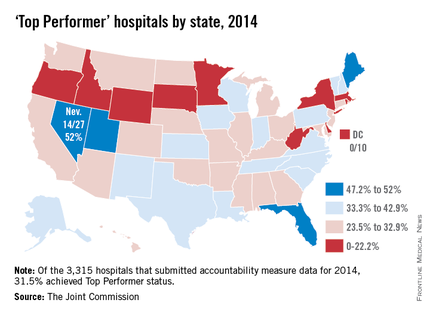Approximately 31% of U.S. hospitals accredited by the Joint Commission earned “Top Performer” status for 2014, the commission said in its annual report for 2015.
Of the 3,315 hospitals that submitted clinical performance data to the Joint Commission for 2014, 1,043 (31.5%) were recognized as Top Performers. Both numbers were down from 2013, when there were 1,224 (36.9%) top-performing hospitals.
The top-performing state was Nevada, which had 14 of 27 hospitals (52%) recognized by the commission. California and Texas tied for the most recognized hospitals at 95 each, but higher total numbers of hospitals gave those states much lower top-performer rates: 31.3% for California and 37.5% for Texas. Florida, with 47.2% of its hospitals recognized, was the only state with 100 or more hospitals to have a top-performer rate of more than 40%, according to the Joint Commission data.
At the other end of the scale, none of the District of Columbia’s 10 submitting hospitals earned Top Performer status. The state with the lowest rate was Wyoming, where just 1 of 11 hospitals (9.1%) was recognized by the commission. At 18.6%, New York was the only one of the nine states with more than 100 submitting hospitals to have a top-performer rate below 20%, the report noted.
Scores for individual hospitals were derived from 12 sets of accountability measures, which include heart attack care, surgical care, children’s asthma care, and stroke care. Top Performers must “achieve cumulative performance of 95% or above across all reported accountability measures; achieve performance of 95% or above on each and every reported accountability measure with at least 30 denominator cases; and have at least one core measure set with a composite rate of 95% or above and, within that measure set, achieve a performance rate of 95% or above on all applicable individual accountability measures.”
The Top Performer program is going on hiatus for 2016 “due to the evolving national performance measure environment – particularly within the Centers for Medicare & Medicaid Services,” Joint Commission president and chief executive officer Dr. Mark R. Chassin said. “I am confident that hospitals will continue to improve, and that in 2017, we will return with a refreshed program that will better fit the evolving national measure environment.”


